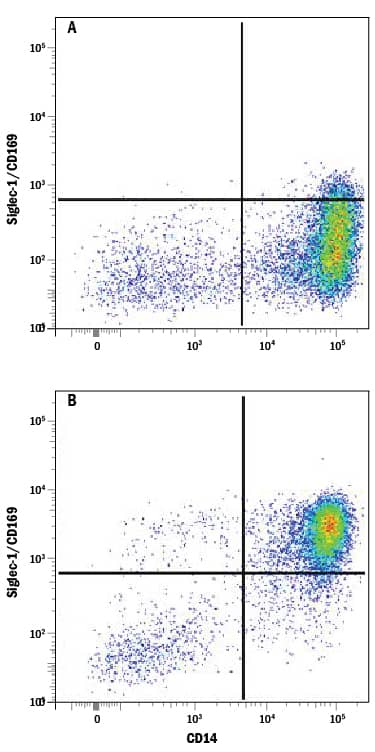Human Siglec-1/CD169 Antibody Summary
Ser20-Gln1641
Accession # Q9BZZ2
Applications
Please Note: Optimal dilutions should be determined by each laboratory for each application. General Protocols are available in the Technical Information section on our website.
Scientific Data
 View Larger
View Larger
Detection of Siglec‑1/CD169 in Human PBMCs by Flow Cytometry. Human peripheral blood mononuclear cells (PBMCs) either (A) untreated or (B) treated with 5 ng/mL Recombinant Human IFN-a (Catalog # 11100-1) overnight were stained with Mouse Anti-Human Siglec-1/CD169 Monoclonal Antibody (Catalog # MAB5197) followed by Allophycocyanin-conjugated Anti-Mouse IgG Secondary Antibody (Catalog # F0101B) and Mouse Anti-Human CD14 PE-conjugated Monoclonal Antibody (Catalog # FAB3832P). Quadrant markers were set based on control antibody staining (Catalog # MAB002).
Reconstitution Calculator
Preparation and Storage
- 12 months from date of receipt, -20 to -70 °C as supplied.
- 1 month, 2 to 8 °C under sterile conditions after reconstitution.
- 6 months, -20 to -70 °C under sterile conditions after reconstitution.
Background: Siglec-1/CD169
Siglecs are sialic acid specific I-type lectins that belong to the immunoglobulin superfamily. Structurally, they are transmembrane proteins with an N-terminal Ig-like
V‑set domain followed by varying numbers of Ig-like C2-set domains (1, 2). Human Siglec-1, also known as sialoadhesin and CD169, is a 175-185 kDa glycoprotein. It contains a 1622 amino acid (aa) extracellular domain (ECD) with one Ig-like V‑set domain and 16 Ig-like C2-set domains, a 21 aa transmembrane segment, and a 44 aa cytoplasmic domain (3). Within the ECD, human Siglec-1 shares approximately 70% aa sequence identity with mouse and rat Siglec-1. Alternate splicing generates a potentially soluble form of the ECD, and a second isoform with a substituted cytoplasmic domain. Siglec-1 expression is restricted to lymph node and splenic macrophages, plus some tissue macrophages (3). The adhesive function of Siglec-1 is supported by the N-terminal Ig-like domain which shows a selectivity for alpha 2,3‑linked sialic acid residues (3‑5). Siglec-1 binds a number of sialylated molecules including the mannose receptor, MGL1, MUC1, PSGL-1, and different glycoforms of CD43 (6‑9). Its binding capacity can be masked by endogenous sialylated molecules (10, 11). The sialylated and sulfated N-linked carbohydrates that modify Siglec-1 itself are required for ligand binding (6, 7). Siglec-1 is expressed on dendritic cells following rhinovirus exposure, and these DC promote T cell anergy (12). It is also induced on circulating monocytes during systemic sclerosis and HIV-1 infection (13‑15). Siglec-1 can trap HIV-1 particles for trans infection of permissive cells (14).
- Varki, A. and T. Angata (2006) Glycobiology 16:1R.
- Crocker, P.R. et al. (2007) Nat. Rev. Immunol. 7:255.
- Hartnell, A. et al. (2001) Blood 97:288.
- Nath, D. et al. (1995) J. Biol. Chem. 270:26184.
- Crocker, P.R. et al. (1991) EMBO J. 10:1661.
- Martinez-Pomares, L. et al. (1999) J. Biol. Chem. 274:35211.
- Kumamoto, Y. et al. (2004) J. Biol. Chem. 279:49274.
- Nath, D. et al. (1999) Immunology 98:213.
- van den Berg, T.K. et al. (2001) J. Immunol. 166:3637.
- Nakamura, K. et al. (2002) Glycobiology 12:209.
- Barnes, Y.C. et al. (1999) Blood 93:1245.
- Kirchberger, S. et al. (2005) J. Immunol. 175:1145.
- York, M.R. et al. (2007) Arthritis Rheum. 56:1010.
- Rempel, H. et al. (2008) PloS ONE 3:e1967.
- van der Kuyl, A.C. et al. (2007) Plos ONE 2:e257.
Product Datasheets
FAQs
No product specific FAQs exist for this product, however you may
View all Antibody FAQsReviews for Human Siglec-1/CD169 Antibody
There are currently no reviews for this product. Be the first to review Human Siglec-1/CD169 Antibody and earn rewards!
Have you used Human Siglec-1/CD169 Antibody?
Submit a review and receive an Amazon gift card.
$25/€18/£15/$25CAN/¥75 Yuan/¥2500 Yen for a review with an image
$10/€7/£6/$10 CAD/¥70 Yuan/¥1110 Yen for a review without an image
